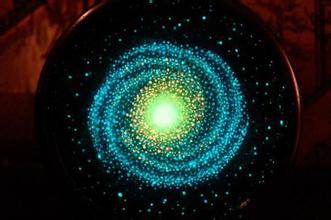The analogy that is usually given for explaining the curvature of space is to try to imagine someone from a universe of flat surfaces, who had never seen a sphere, being brought to Earth. No matter how far he roamed across the planet's surface, he would never find an edge. He might eventually return to the spot where he had started, and would of course be utterly confounded to explain how that had happened. Well, we are in the same position in space as our puzzled flatlander, only we are flummoxed by a higher dimension.
为了解释空间是弯曲的,人们经常提出一个类比,他们试图想像,有个来自平面宇宙、从来没有见过球体的人来到了地球。不管他在这颗行星的表面上走得多远,他永远也走不到边。他很可能最终回到始发地点。他当然会稀里糊涂,说不清这是怎么一回事。哎呀,我们在空间的处境,跟那位先生的处境完全相同。我们只是糊涂得更厉害罢了。

Just as there is no place where you can find the edge of the universe, so there is no place where you can stand at the center and say: "This is where it all began. This is the centermost point of it all." We are all at the center of it all. Actually, we don't know that for sure; we can't prove it mathematically. Scientists just assume that we can't really be the center of the universe—think what that would imply—but that the phenomenon must be the same for all observers in all places. Still, we don't actually know.
如同你找不着宇宙的边缘一样,你也不可能站在宇宙的中心,说:"宇宙就是从这儿开始。这是一切的最中央。"我们大家都在一切的最中央。实际上,我们对此缺少把握。我们无法用数学来加以证实。科学家们只是推测,我们确实是在宇宙的中央--想一想,这会意味着什么--但是,这种现象对所有地方的所有观察者来说都是一样的。不过,我们真的没有把握。
For us, the universe goes only as far as light has traveled in the billions of years since the universe was formed. This visible universe—the universe we know and can talk about—is a million million million million (that's 1,000,000,000,000,000,000,000,000) miles across. But according to most theories the universe at large—the meta-universe, as it is sometimes called—is vastly roomier still. According to Rees, the number of light-years to the edge of this larger, unseen universe would be written not "with ten zeroes, not even with a hundred, but with millions." In short, there's more space than you can imagine already without going to the trouble of trying to envision some additional beyond.
据我们所知,自形成以来,宇宙只发展到光走了几十亿年那么远的距离。这个可见的宇宙--这个我们知道而且在谈论的宇宙--的直径是1.5亿亿亿(即1 500 000 000 000 000 000 000 000)公里。但是,根据大多数理论,整个宇宙--有时候称之为超宇宙--还要宽敞得多。根据里斯的说法,到这个更大的、看不见的宇宙边缘的光年数,不是"用10个0,也不是用100个0,而是用几百万个0"来表示。简而言之,现有的空间比你想像的还要大,你不必再去想像空间外面还有空间。













